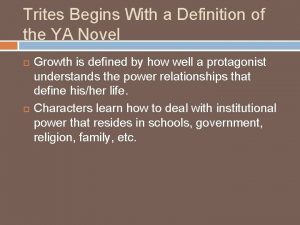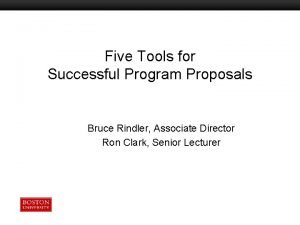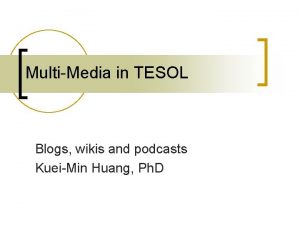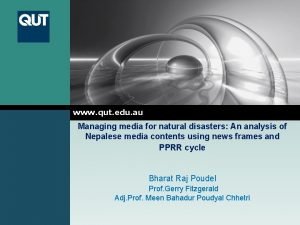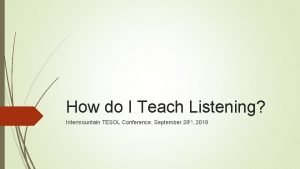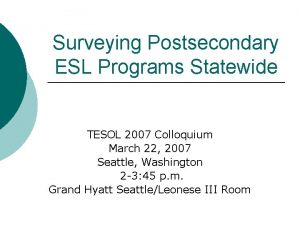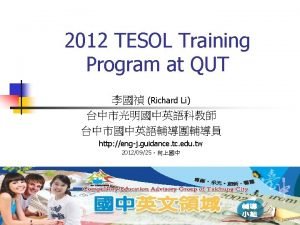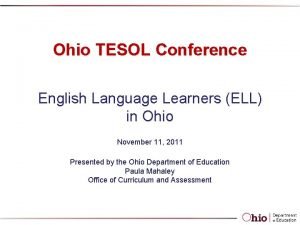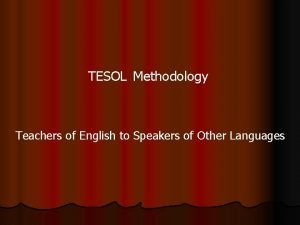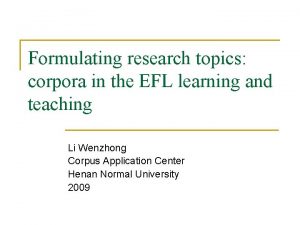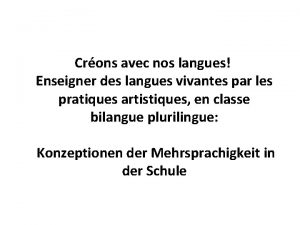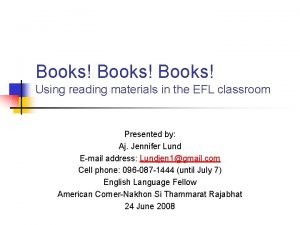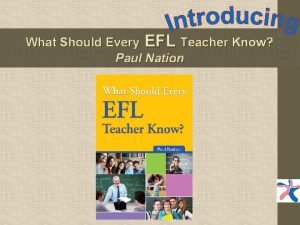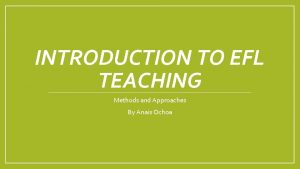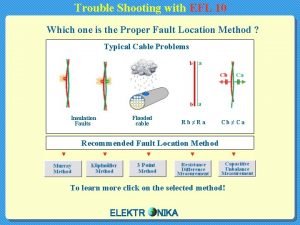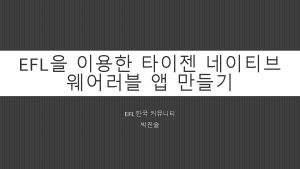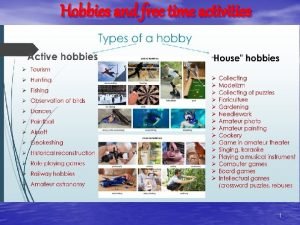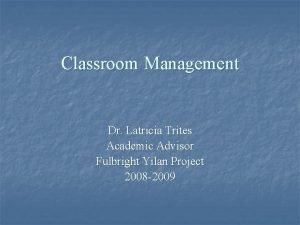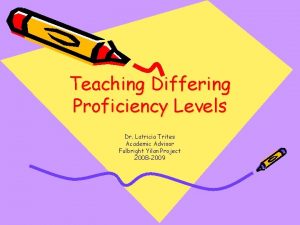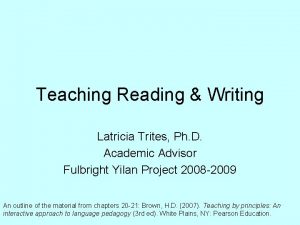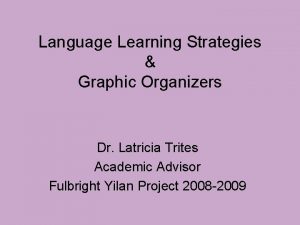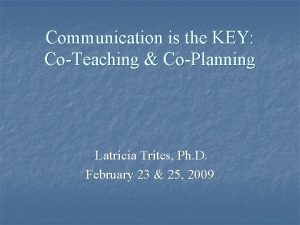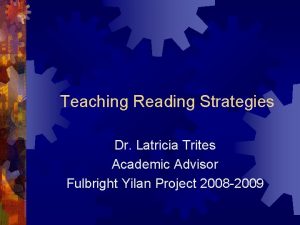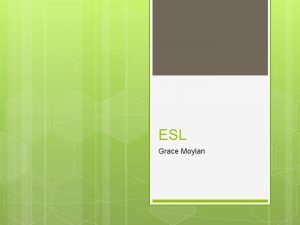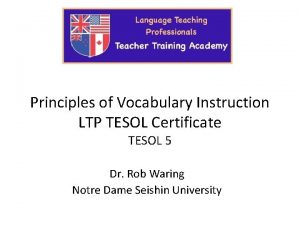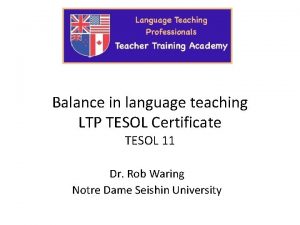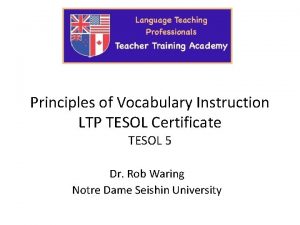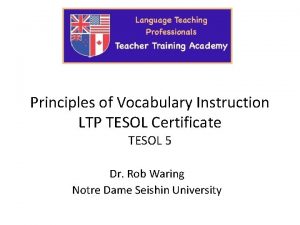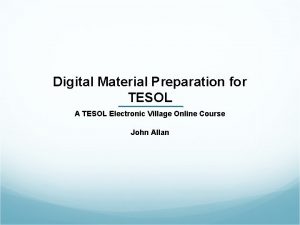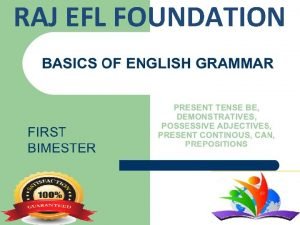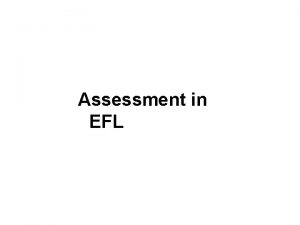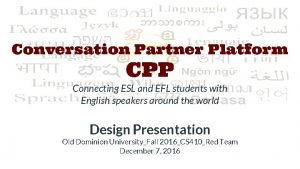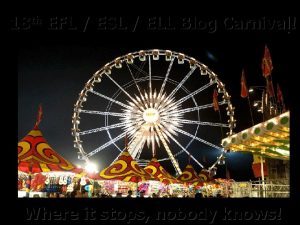TESOL ESL or EFL Latricia Trites Ph D





















- Slides: 21

TESOL, ESL, or EFL Latricia Trites, Ph. D. Academic Advisor Fulbright Yilan Project August 8, 2008

Overview 4 Basic Introduction of Terms and Concepts 4 Consideration of English Culture 4 Consideration of First Language 4 Consideration of Home Culture 4 General Strategies & Tips 4 Resources

Alphabet Soup 4 TESOL/TESL 4 ESL/EFL 4 ESP 4 LEP 4 L 1/L 2 4 BICS/CALP 4 TOEFL

Why Learn English? 4 Business opportunities/advancement 4 World Super Power 4 Educational Opportunities 4 Parental Pressure 4 National Educational Mandates

A BRIEF History of Language Teaching Methods 4 Grammar Translation 4 Direct Method 4 Situational Language Teaching/Audiolingualism (ALM) 4 Reading Method 4 Designer Methods – – – Community Language Learning Suggestopedia Silent Way Total Physical Response (TPR) Natural Approach

Post Methods Approaches 4 Communicative Language Teaching (CLT) 4 Task-Based Language Teaching 4 Whole Language Education 4 Content-Based Instruction (CBT) 4 Lexical Approach 4 Multiple Intelligences (MI)

So is there ONE BEST Way? 4 In a word, NO. 4 Depends on many factors such as (to name just a few) – Personality style of teacher – Teaching style – Situational context • Age of students • Purpose for learning the language • Location of classroom

Common Methods of ESL Instruction 4 Early Out 4 Bilingual 4 Pull-out 4 Push-in 4 Sheltered 4 Immersion 4 Submersion

What do YOU bring to the classroom? 4 What characteristics describe what it means to be “American”? 4 What are some headlines, advertisements, texts, class/school rules that display American values? 4 Discuss your own experiences with culture shock.

Considerations for Ethnocentric Beliefs 4 From Kohls, L. R. (2001) Survival Kit for Overseas Living. – – – – Personal control over environment/responsibility Change seen as natural and positive Time Equality/fairness Individualism/independence Self-help/initiative Competition Future orientation Action/work oriented Informality Directness/openness/honesty Practicality/efficiency Materialism

Non-verbal Communication 4 Kinesics – body language 4 Proxemics – personal distance 4 Paralinguistics – elements of speech 4 Haptics – Touch 4 Olfactics – Smell 4 Oculesics - Sight 4 Chronemics – Time

Considerations of Native Culture 4 Become informed about the various cultures represented by your students. 4 Recognize that these students have been trained according to their own culture when it comes to school related issues such as 4 What are possible considerations that you should consider for the classroom? – Teacher – Student Relationships – Teacher – Parent Relationships – Typical Classroom Behaviors • Looking at the Teacher • Asking Questions • Homework 4 TIP: Don’t write a student’s name in Red.

Considerations for First Language 4 What do you know about the structure of the Chinese language? How is it similar or different from English? 4 Understand L 1 belief about texts 4 Understand L 1 approach to writing/argument style 4 Understand L 1/L 2 differences that may cause problems – Alphabet system (writing form) – Use of plurals – Use of tense markers

General Teaching Strategies & Tips 4 Use more than one method of giving instructions. (tapes, videos, etc. ) 4 Check for comprehension beyond “Any questions? ” “Do you understand? ” 4 Train and model effective learning and problem-solving strategies.

More Strategies & Tips 4 Use both verbal and non-verbal cues to help students recall information, organize their ideas, and use strategies for planning. 4 Use graphic organizers. 4 Use language that is repetitive and easily understandable. 4 Allow students to respond in as complete a form as possible.

More Strategies & Tips 4 Use music; it’s motivating and helps students in a variety of ways. 4 Try to incorporate multicultural stories. 4 Encourage students to share their culture/history.

Tips to Use with Beginners 4 Use a slower rate of speech, enunciate clearly, and emphasize key words and phrases through gestures, facial expressions, and intonation. 4 Pause between phrases 4 Use visuals to clarify key concepts. 4 Demonstrate and act out when appropriate. 4 Modify texts leaving pertinent information, removing extraneous details.

Tips for Intermediate or Advanced 4 Add as much contextual support as possible to lessons and reading assignments. 4 Design schema building activities. 4 Provide models that students can emulate. 4 Incorporate group work whenever appropriate.

Resources 4 Alta Books http: //www. altaesl. com/ 4 Body Language 4 4 4 http: //users. telenet. be/bodylanguage 2006/index. html Center for Applied Linguistics: Resources http: //www. cal. org ESL Resource Center http: //eslus. com/eslcenter. htm Dave’s ESL Café http: //www. eslcafe. com ESL-Images http: //www. esl-images. com/ ESL Resource Center http: //members. aol. com/eslkathy/esl. htm English Teaching Forum http: //exchanges. state. gov/forum

Additional Resources 4 Heinemann Library www. heinemannlibrary. com & www. heinemannclassroom. com 4 One Stop English www. onestopenglish. com 4 Online Materials on EFL and Related Topics: An Essential Bibliography for English Language Teaching and Applied Linguistics http: //exchanges. state. gov/education/engteachin g/eltbib. htm 4 Oxford English http: //www. oup. com/elt/ 4 Pearson Longman http: //www. longman. com/

Additional Resources 4 Questia: The World’s Largest Online Library http: //www. questia. com 4 Rubistar http: //www. rubistar 4 teachers. com 4 Scott Foresman http: //www. scottforesman. com/ 4 TESOL www. tesol. org 4 Track Star http: //trackstar. 4 teachers. org. 4 The Internet Picture Dictionary www. pdictionary. com 4 TESL-EJ http: //www-writing. berkeley. edu/TESLEJ/
 Why did the cow keep jumping over the barrel
Why did the cow keep jumping over the barrel Roberta seelinger trites
Roberta seelinger trites Trites definition
Trites definition Boston university tesol
Boston university tesol Tesol course university of queensland
Tesol course university of queensland Tesol wiki
Tesol wiki Tesol course qut
Tesol course qut Intermountain tesol
Intermountain tesol Ucsb extension tesol
Ucsb extension tesol Tesol course qut
Tesol course qut Ohio tesol
Ohio tesol Roughly tuned input
Roughly tuned input Dr ray efl
Dr ray efl Efl research topics
Efl research topics Enseigner deutsch
Enseigner deutsch Efl reading materials
Efl reading materials What should every efl teacher know pdf
What should every efl teacher know pdf Efl
Efl Efl poznań
Efl poznań Efl 10
Efl 10 Tizen efl
Tizen efl Talking about your free time and hobbies
Talking about your free time and hobbies


